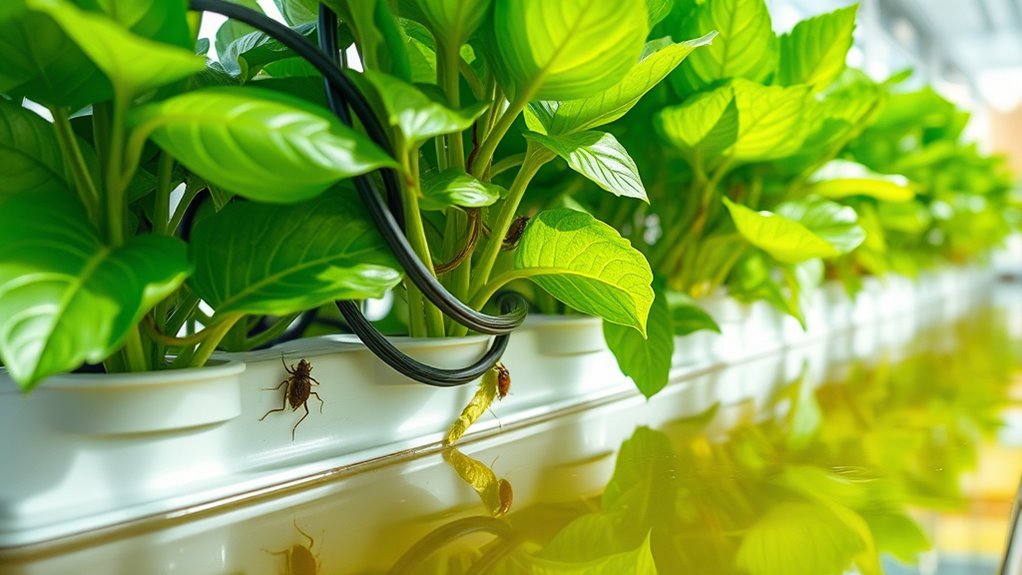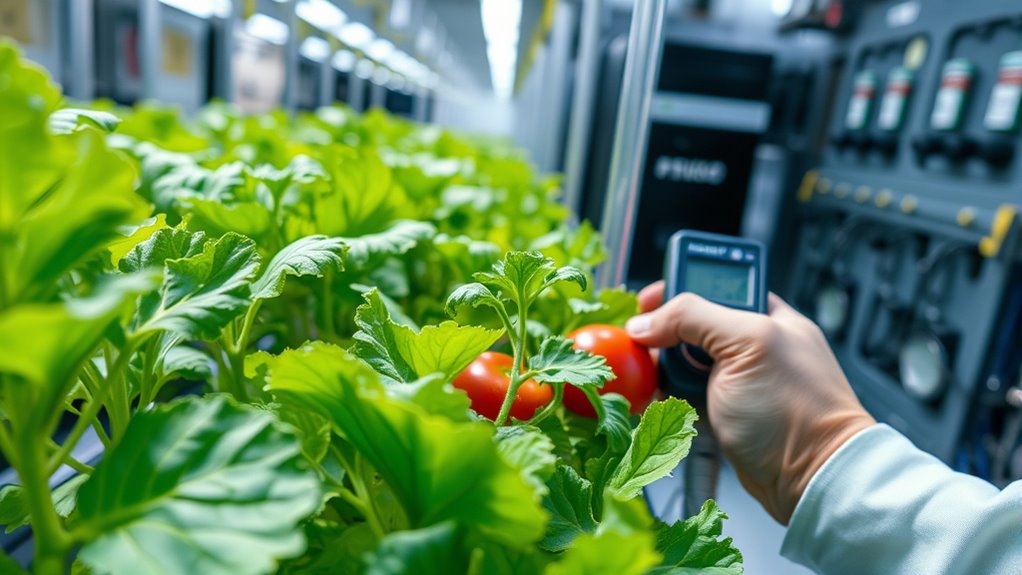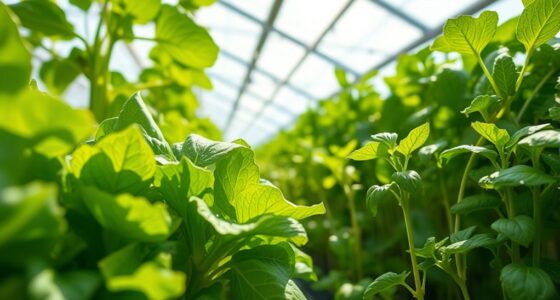To troubleshoot your hydroponic system, regularly check and adjust your pH within 5.5 to 6.5 to prevent nutrient imbalances. Inspect roots for signs of disease like browning or foul smells, and improve aeration if needed. Monitor plants for pests such as aphids or spider mites, and keep the environment clean. Make certain your equipment runs smoothly by cleaning filters and fixing glitches promptly. By staying vigilant, you’ll catch issues early and keep your plants healthy—learn how to prevent problems before they escalate.
Key Takeaways
- Regularly test and adjust pH levels between 5.5 and 6.5 to prevent nutrient deficiencies or toxicities.
- Inspect roots for discoloration, foul smell, or sliminess; improve oxygenation and reduce moisture to prevent root diseases.
- Conduct routine pest inspections and maintain cleanliness; quarantine new plants and ensure good airflow to prevent infestations.
- Check and clean system components like pumps and filters; promptly repair or replace faulty equipment to ensure consistent nutrient delivery.
- Monitor plant health closely, act quickly on signs of imbalance or pests, and maintain system cleanliness to prevent issues proactively.

Hydroponic gardening offers a fast and efficient way to grow plants, but it also comes with its own set of challenges. One of the most common issues you’ll face involves maintaining the proper pH level of your nutrient solution. When pH swings too high or low, it can hinder your plants’ ability to absorb essential nutrients, leading to deficiencies or toxic buildups. Regular pH adjustment is vital; you should test your solution frequently and use pH up or down solutions to keep levels within the ideal range, typically between 5.5 and 6.5 for most crops. Ignoring pH can cause weak growth, leaf discoloration, and increased susceptibility to root disease. Root disease, in particular, becomes a serious concern when pH levels aren’t balanced because it creates an environment conducive to harmful fungi and bacteria. If roots start to turn brown, smell foul, or become slimy, it’s a sign you need to act fast. You might need to improve drainage, reduce moisture levels, or add beneficial microbes to combat these pathogens. Guaranteeing proper oxygenation of the root zone also helps prevent root disease, so consider adding an air stone or increasing aeration in your system.
Besides pH issues, pests and diseases can quickly devastate your hydroponic setup. Pests like aphids, spider mites, and fungus gnats can sneak in and damage your plants, especially if you neglect regular inspection. Keeping your environment clean and quarantining new plants reduces the risk of infestations. For diseases, preventing overwatering and ensuring good airflow are key strategies. If you detect any signs of fungal or bacterial infections, you may need to sanitize your system with a suitable antimicrobial solution or remove affected plants immediately to prevent spread. System glitches, such as clogged pumps or inconsistent nutrient delivery, also cause problems that can look like nutrient deficiencies or poor growth. Regularly check your equipment to guarantee everything functions smoothly. Clean filters and replace parts as needed. If your plants aren’t thriving, review your system’s operation, making sure the water flow is steady and the nutrients are being supplied evenly.
Troubleshooting hydroponic problems requires vigilance and prompt action. By staying attentive to pH levels, root health, and system functionality, you’ll minimize risks like root disease and nutrient imbalances. This proactive approach keeps your plants healthy, productive, and thriving in your hydroponic garden.
Frequently Asked Questions
How Do I Prevent Algae Growth in My Hydroponic System?
To prevent algae growth in your hydroponic system, focus on algae prevention by reducing light exposure to the nutrient solution. Use opaque containers or cover tanks with non-transparent material to block light. Guarantee proper light management by limiting the duration and intensity of light reaching your system. Regularly clean and maintain your setup, and keep the nutrient solution covered when not in use. These steps help inhibit algae and keep your plants thriving.
What Are Signs of Root Rot in Hydroponic Plants?
You’ll notice root rot symptoms as your plants start to show stunted growth, yellowing leaves, or wilting despite proper watering. If you gently examine the roots, you might see they’re brown, slimy, or foul-smelling—clear signs of plant decay. These symptoms indicate root rot, which occurs when conditions like overwatering or poor oxygen levels promote harmful bacteria. Address it quickly by improving oxygen flow and trimming affected roots.
How Often Should I Replace Nutrient Solutions?
You should replace your nutrient solution regularly to maintain nutrient solution freshness and ideal plant growth. Typically, it’s best to do a complete replacement every 1 to 2 weeks, depending on your system and plant needs. Frequent replacement prevents nutrient imbalances and buildup of waste, ensuring your plants receive the proper nutrients. Keep an eye on pH levels and electrical conductivity (EC) to determine if a partial change is needed sooner.
Can Hydroponic Systems Be Used Outdoors Safely?
You can definitely use hydroponic systems outdoors, but you need to take into account weather conditions carefully. Outdoor cultivation exposes your system to rain, wind, and temperature fluctuations, which can impact plant health. Make sure your setup is weatherproof and monitor conditions regularly. Protect your system from extreme weather, and choose a sheltered location if needed to maintain consistent nutrient delivery and prevent system glitches caused by environmental factors.
What’S the Best Way to Troubleshoot Ph Fluctuations?
To troubleshoot pH fluctuations, start with accurate pH testing methods like digital meters or test strips. Regularly check your nutrient solution and record the readings. If you notice swings, use buffer solutions to stabilize the pH quickly. Consistent testing and adjusting with buffer solutions help maintain steady pH levels, preventing nutrient lockout and ensuring your plants absorb nutrients effectively. Stay vigilant and adjust your system accordingly.
Conclusion
By staying vigilant and addressing issues promptly, you can keep your hydroponic system thriving. For example, a grower noticing yellowing leaves quickly adjusted their nutrient levels, saving their plants from decline. Remember, regular checks for pests, nutrient balance, and system glitches are key. With attentive care, you’ll enjoy healthy, lush crops and avoid costly setbacks. Keep troubleshooting and learning, and your hydroponic garden will flourish for years to come.










